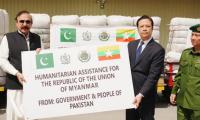ISLAMABAD: Afghanistan’s authorities with the help of Indian experts have completed the feasibilities and detailed engineering of 12 hydro-power projects with capacity to generate 1,177MW of electricity to be built on the river Kabul.
If the 12 projects get completed, they will store 4.7 million acre feet of water squeezing the flow in the river reaching Pakistan.
India, which also helped Afghanistan in repairing the Friendship Dam (Salma Dam) on the river Chishti-e-Sharif in Herat province, is already erecting the hydro-power projects on the Chenab, Jhelum and Indus with an objective to get the capacity to maneuver water flows destined to reach Pakistan and is now active to squeeze the water artery coming from Afghanistan.
According to a document exclusively available with The News, Indian experts have completed the feasibilities and detailed engineering of the 12 projects to be built on the river Kabul. The authorities in Kabul after completing the tendering process will be initiating construction of multi-purpose water projects on the tributaries of the river Kabul with assistance from the international community. India plans to assist Afghanistan in this initiative, which will adversely impact on Pakistan. The documents also show that the World Bank will provide funding for the 12 dams that will cost $7.079 billion.
The most ironic part of the whole episode is that Pakistan’s authorities have failed to develop water uses on the river Kabul as they failed to build the Kalabagh Dam at the site on the Indus where the river Kabul merges with the river Indus.
Similarly, Pakistan’s authorities have also failed to construct the Munda Dam on the river Kabul. The failure in developing water uses has weakened Pakistan’s case against the resolve of Afghanistan to build the 12 hydro-power projects on the river Kabul.
The documents unveil that four hydro-power projects will be constructed in the Punjshir sub-basin. These include the $332 million Totumdara project which will generate 200MW of electricity and have water storage capacity of 332,510 acres feet; the $1.174b Barak project which will generate 100MW of electricity and store 429,830 acres feet of water; $1.078 billion Panjshir (100MW) project with the capacity to store 105,4300 acres feet of water; and the $607 million Baghdara (210MW) project with the capacity to store 324,400 acres feet of water.
In the Logur Upper Kabul sub-basin on the river Kabul four more dams are to be built which include the $72 million Haijana project (72MW) with water storage capacity of 178,420 acres feet; $207 million Kajab (15MW) project with water storage capacity of 324,400 acres feet; the $356 million Tangi Wadag (56MW) project with capacity to store 283,850 acres feet; and $51m Gat (86MW) project with water storage capacity of 405,500 acres feet. Four more dams will be built in the Lower Kabul sub-basin, including the $442 million Sarobi project (210MW) with the capacity to store 324,400 acres feet of water; the $1.434 billion Laghman project (1251MW) with water storage capacity of 233,568 acres feet; and the $1.094 billion Konar (A) (94.8MW) and Kama projects (11.5MW).
Pakistan and Afghanistan currently share nine rivers with annual flows of about 18.3 million acres feet (MAF) of which the river Kabul accounts for 16.5MAF, while River Chitral, which originates from Pakistan, contributes about 8.5MAF. After it enters Afghanistan this river is called River Kunar. It joins the river Kabul near Jalalabad and then re-enters Pakistan.
However, the documents say: “Ninety percent of Afghanistan’s land area is located in the five river basins namely: Panj-Amu Darya River Basin, Northern River Basin, Harirud-Murghab Basin, Helmand River Basin and river Kabul basin. The total storage capacity of these dams is around 4.7 million acre feet. It is further estimated that the planned dams will utilise 0.5 MAF water to irrigate additional 14,000 acres of land.
“Afghanistan has the right to utilise water from the river Kabul as the total flow of Kabul River is 21,000 million cubic meter. But the river Kunar, which contributes 15,000 million cubic meter to the river Kabul, originates from Pakistan.
“In the absence of major dams in Pakistan, it is feared that Pakistan will have to buy electricity from Afghanistan, which is the underlying purpose of the above mentioned plan of the Afghan government in collaboration with India.”
However, Syed Mehr Ali Shah, Joint Secretary (Water Wing) in the Ministry of Water and Power said that all the water uses of river Kabul are 100 percent committed up to Kotri Barrage. Pakistan is the country which is facing water deficit and has total water flows in its rivers and dams stand at 137 MAF and these water uses have been developed for the last many decades and no upper riparian country like Afghanistan can utilize the committed water uses of Pakistan.
Mr Shah said that Afghanistan could utilize 2.5 MAF water for irrigation purposes at the maximum. However, at Warsak, Pakistan has committed water flows of river Kabul of 16-17 MAF out of which 8-8.5 MAF water comes from the river Chitral which generates from Pakistan. “No doubt it is the failure of the authorities and political leadership of not building the Kalabagh Dam and Munda Dam, but if the said dams are not built, even then Pakistan’s water uses of river Kabul are established and Pakistan’s case is very strong if needed to move any international forum,” he claimed.
When asked about the huge quantum of 36 MAF water that went down the drain during the flood season, Mr Shah said that it was flood water which could not be stored. However, in the remaining months, Pakistan faces the water deficit and the Kabul water uses are 100 percent committed in Pakistan. He said since there is no water treaty with Afghanistan, but under the international convention Pakistan has the right to utilise 17 MAF water in river Kabul as the said water uses are committed in lower riparian country. Likewise Afghanistan uses 1.8 MAF which is its developed water rights. Both the countries under the international convention are bound to continue to utilise their developed water uses. To a question Mr Shah said that Munda is being built on Sawat basin which is Pakistan’s own basin.
Talking about the 4.7 MAF water to be stored in 12 hydropower project being built on river Kabul, Mr Shah said that it was not correct as the water storage would not be more than 2 MAF. However, in the initial filling, the said projects may store the water more than 2 MAF, but after that projects will not be able to store more than 2 MAF. However, the Afghanistan if tries its best, it can use 2.5 MAF water from river Kabul to irrigate its plain lands at the maximum.
Opposition parties strongly criticised move, accusing BJP government of targeting Muslim community ahead of Eid
“Efforts of KP government, led by CM Ali Amin Gnadapur are yielding positive results,” he said in a statement
Despite progress, Khyber-Pakhtunkhwa and Balochistan remain epicentres of violence
As always, Geo Network has curated an exceptional lineup of programming to make Eid even more memorable
£275,000 vehicle was engulfed in flames, prompting bystanders to attempt to extinguish the fire
Bilawal Bhutto Zardari met with flood-affected women and informed them about details of houses







